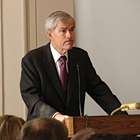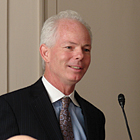
Senator Jeff Bingaman (D-N.M.) keynotes a Danfoss EnVisioneering Symposium at the Russell Senate Building.
Robert Wilkins, vice president, public & industry affairs for Danfoss, welcomed the group and stated the goal of the event was to “map out the new conditions in which the industry and policy makers are operating,” and he emphasized the need to work together.
Bingaman outlined “four things we need to do as a nation”: lead in energy research and development, especially renewable sources; develop a strong domestic market for clean energy; establish a financial infrastructure so that people have the incentive to invest; and finally promote United States manufacturing capabilities. He shared that his committee was attempting to revise the Clean Energy bill introduced in the last Congress and admitted getting any bill through the Senate will be difficult. Bingaman lamented, “There are many in congress that don’t share a desire to legislate.”
Yurek highlighted major shipment trends in the air conditioning and heating market. According to Yurek, new construction has declined severely to 1964 levels. He also showed that furnace and air conditioning shipments declined to levels not seen since the 1990s. On a positive note, he also provided life cycle information that indicates the growth of new construction and central air conditioning in the last 15 years means there will be a big increase in the replacement market in the next 3 to 4 years.
Yurek emphasized, “Our industry is a success story” because equipment is 40 percent more efficient than in the 1990s. He also highlighted a government report which shows space heating and air conditioning made up a smaller percentage of home energy use in 2005 than in 1978, even though the percentage of homes with central air conditioning grew from 23 percent in 1978 to over 60 percent in 2005. Yurek then cautioned the group that the HVAC industry is “maxed out” on efficiencies and there is a need for a “new modeling system” and the industry needs to commit dollars to research. To that end, he announced that AHRI and the American Society of Heating, Refrigerating and Air-Conditioning Engineers (ASHRAE) had agreed to jointly commit more funds to research.

Dave Kyle, vice chairman of ACCA discusses the challenges of installing HVAC systems that operate at peak efficiencies.
CONTRACTOR PERSPECTIVE
David Kyle, owner of Trademasters, a D.C. area contracting firm gave the contractor’s perspective. He stated the HVAC industry is the No. 1 user of natural resources in America by citing a DOE report that it represents 42 percent of energy consumption in the home and 28 percent in buildings. He cautioned that significant changes in consumption can’t be achieved simply by designing a new product. He used the analogy of a light bulb being replaced with a LED light to save energy. That is an easy fix. But according to Kyle, “HVAC is hard.” Today’s equipment is well designed and manufactured and the training materials are first-rate; however, it needs to be installed properly in order to achieve maximum efficiencies. Factors like sizing, air flow, system charging, and air leakage in the ducts can have a significant impact on the SEER performance of a system.Kyle provided a road map to the future to ensure systems achieve maximum efficiency. First, ensure that minimum requirements are met. Excellent codes and standards are already in place to help make that happen. He mentioned IAPMO, ASHRAE, and ACCA standards that properly set the bar for contractors. Next he said “we need to level the playing field” by taking a stand against improper installations. Speaking for contractors he said, “Force me to do it right.” He added the industry needs to promote good contractors by providing incentives to do the job right and providing education. He even called for third party commissioning on jobs. “Give us a bar to hit,” urged Kyle.
Trane’s Eugene Smithart challenged the group to think “outside the box” when coming up with solutions to save energy and urged them not to accept the premise that high efficiency systems mean higher installation or first cost in order to achieve power operating costs. He gave an example of an innovative air cooled chiller system that uses partial ice storage to assist with cooling during peak demand. The system lowers initial cost because it requires a smaller chiller and it lowers operating cost by lowering energy usage when Kwh costs are the highest.
Publication date:07/25/2011

Report Abusive Comment